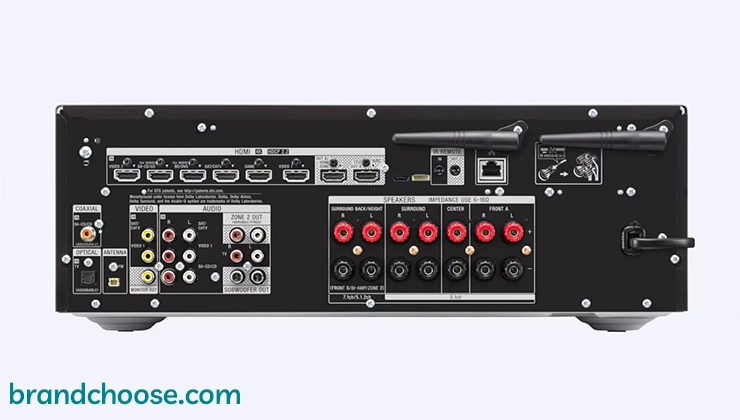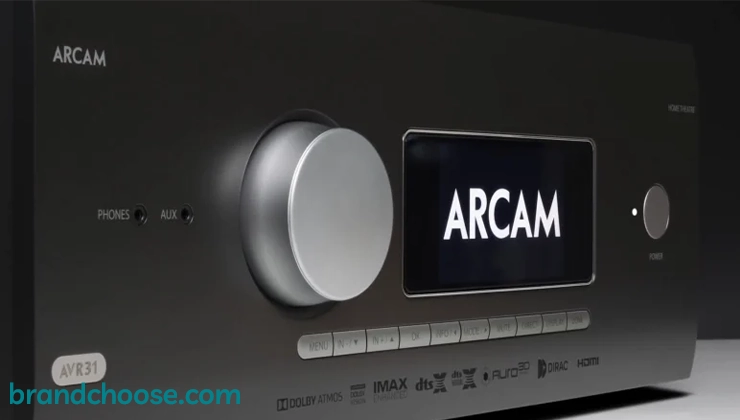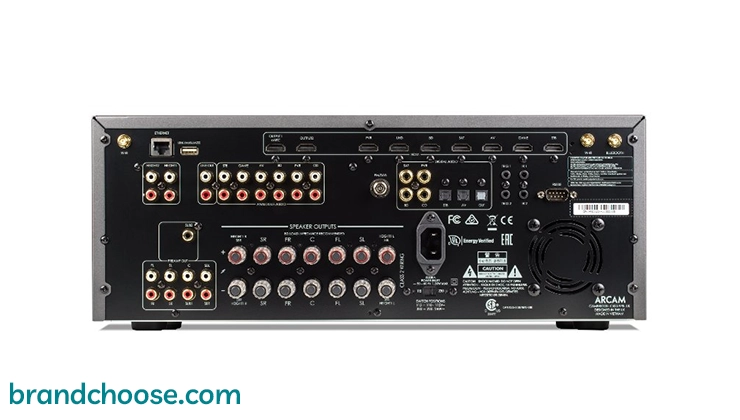Sony AV Receivers
In the realm of home entertainment, the heart of a truly immersive experience lies within the audio-visual (AV) receiver. Among the myriad of options available, Sony AV receivers stand out as beacons of innovation, performance, and reliability. In this article, we delve into the realm of Sony AV receivers, uncovering what makes them exceptional, their unique features, advantages, disadvantages, and why they deserve a place in your home theater setup.
What are Sony AV Receivers?
Sony AV receivers serve as the nerve center of your home entertainment system, designed to decode, amplify, and distribute audio and video signals with precision and clarity. Infused with cutting-edge technology and decades of audio expertise, Sony receivers deliver an unparalleled audio-visual experience that captivates the senses and transports you into the heart of the action.
Why are Sony AV Receivers superior?
Number of channels
Sony offers a variety of AV receivers with different numbers of channels to cater to various user needs. The number of channels in Sony AV receivers ranges from 5.2 to 9.2, which provides users with a broad spectrum of options to choose from based on their specific requirements. For instance, Sony's STR-DN1080, a 7.2 channel AV receiver, is equipped with Dolby Atmos and DTS:X support, offering a comprehensive home theater experience. On the other hand, the Sony STR-ZA5000ES, a 9.2 channel AV receiver, offers an expanded sound field with its nine channels, providing a more immersive audio experience. In terms of technology, Sony AV receivers with more channels are equipped with the latest features such as 4K HDR compatibility, High-Resolution Audio, and Music Connect, enhancing the overall audio-visual experience. However, a potential downside could be the complexity of setup and calibration with more channels. Compared to other brands like Yamaha and Denon, Sony's AV receivers are competitive in terms of the number of channels offered, technology, and price. However, some users have noted that brands like Denon may offer a slightly better sound quality in their high-end models.
Connectivity options
Sony's AV receivers are renowned for their extensive connectivity options, incorporating the latest technologies to ensure seamless integration with a variety of devices. The brand's models typically include multiple HDMI inputs and outputs, USB ports, and digital audio inputs. For wireless connectivity, many Sony AV receivers are equipped with Bluetooth, Wi-Fi, and AirPlay capabilities, allowing for easy streaming from smartphones, tablets, and computers. Some models also support multi-room listening through Sony's Music Center app, providing a convenient way to control and distribute audio throughout the home. However, while Sony's AV receivers offer robust connectivity, they do not always support the latest HDMI standards, such as eARC or HDMI 2.1, which could be a drawback for those looking to future-proof their home theater setup. In comparison, brands like Denon and Marantz often include these features in their AV receivers. Nevertheless, Sony's connectivity options are generally reliable and versatile, making them a strong choice for those seeking to connect a wide range of devices.
Power output
Sony's AV receivers are renowned for their robust power output, which is a critical factor in determining the overall audio quality. The power output of Sony's AV receivers, such as the Sony STR-DN1080, which delivers 165 watts per channel, is impressive. This high power output ensures that the audio signal is strong enough to drive a wide range of speakers, providing clear, distortion-free sound even at high volumes. Sony's AV receivers utilize advanced technologies like the Digital-to-Analog Converter (DAC), which enhances the power output and ensures that the sound quality remains top-notch, regardless of the source. However, while Sony's power output is generally reliable and efficient, it can sometimes fall short when compared to other brands like Denon or Yamaha, which offer AV receivers with higher power output. For instance, the Denon AVR-X3600H provides 180 watts per channel, and the Yamaha RX-A2080 offers 140 watts per channel but with superior current capability and low impedance drive. This could potentially result in a more dynamic sound experience. Sony's power output, though, is often considered more than sufficient for most home theater systems and is praised for its consistency and stability.

Sound quality
Sony, a renowned brand in the realm of AV receivers, is highly recognized for its sound quality. The company utilizes the latest technologies such as Dolby Atmos, DTS:X, and S-Force PRO front surround technology to deliver a rich, immersive audio experience. Sony's AV receivers are also equipped with High-Resolution Audio capability, which can play a wider range of frequencies than other formats like MP3s, making the sound closer to the original studio recording. However, while the sound quality of Sony's AV receivers is generally excellent, some users have reported that the bass response can sometimes be less powerful compared to other brands. Furthermore, the sound quality can be influenced by the type of speakers used, the room's acoustics, and the quality of the audio source. When compared to other brands like Denon or Yamaha, Sony's AV receivers offer competitive sound quality, although some audiophiles argue that these other brands may offer a slightly warmer and more balanced sound. Regardless, Sony's commitment to incorporating the latest sound technologies into their AV receivers ensures a high-quality audio experience for most users.
Arcam AV Receivers
In the realm of home entertainment, the heart of a truly immersive experience lies within the audio-visual (AV) receiver. Among the myriad of options available, Arcam AV receivers stand out as beacons of innovation, performance, and reliability. In this article, we delve into the realm of Arcam AV receivers, uncovering what makes them exceptional, their unique features, advantages, disadvantages, and why they deserve a place in your home theater setup.

Feauturs you need to know about Arcam AV Receivers
Sound quality
Arcam, a renowned brand in the AV receivers category, is globally recognized for its exceptional sound quality. The brand utilizes the latest technologies such as Class G amplification, which ensures optimal sound performance by reducing distortion and enhancing audio clarity. Arcam's AV receivers, such as the AVR20 and AVR30, are equipped with the state-of-the-art ESS Sabre DACs (Digital-to-Analog Converters), which significantly contribute to the high-resolution audio output, providing a rich, detailed, and immersive sound experience. However, while the sound quality of Arcam's AV receivers is commendable, it's worth noting that they are generally more expensive than other brands offering similar features. This could be a potential drawback for budget-conscious consumers. Compared to other brands like Denon or Yamaha, Arcam stands out for its emphasis on sound performance over extensive features. While brands like Denon might offer a wider array of connectivity options or Yamaha might focus on versatility with music streaming services, Arcam's primary focus remains on delivering superior sound quality. Therefore, for audiophiles who prioritize sound quality above all, Arcam's AV receivers could be an excellent choice.
Number of channels
Arcam, a renowned name in the AV receivers category, offers a range of products with varying numbers of channels, catering to different user needs. Their latest models, such as the AVR30 and AVR20, offer 7.1.4 and 7.1.2 channels respectively. These models are equipped with the latest technologies including Dolby Atmos, DTS:X, and IMAX Enhanced, providing a rich and immersive audio experience. One of the key advantages of Arcam AV receivers is their ability to deliver high-quality sound across all channels, making them an excellent choice for home theaters. However, compared to some other brands, Arcam receivers might be limited in terms of the number of channels they offer. Brands like Denon or Marantz, for instance, offer AV receivers with up to 11 or 13 channels. This could be a potential drawback for users looking to set up more complex home theater systems. Nonetheless, Arcam's focus on sound quality over quantity sets them apart, and they continue to be a strong contender in the AV receiver market.
Power output
Arcam, a renowned brand in the AV receivers category, is well recognized for its power output. The brand's latest models, such as the AVR390, AVR550, and AVR850, are equipped with the latest technologies that ensure a high power output. The AVR850, for instance, boasts a class G amplification, delivering over 120 watts per channel, which is quite impressive. This high power output ensures that the audio is loud, clear, and distortion-free even at high volumes, providing an immersive audio experience for users. However, it's worth noting that while Arcam's power output is commendable, it may not always be the most energy-efficient, especially when compared to brands like Denon or Yamaha. These brands have incorporated Eco mode in their AV receivers, which helps in reducing power consumption. Despite this, Arcam's power output quality is still highly competitive. The brand's focus on delivering high power output without compromising on the audio quality sets it apart from many other brands in the AV receivers category.

Connectivity options
Arcam, a renowned brand in the AV receivers category, offers a variety of connectivity options in their models that cater to the needs of modern users. One of the key features is the inclusion of HDMI 2.1 ports, which support 8K/60Hz and 4K/120Hz video pass-through, ensuring compatibility with the latest high-definition video formats. Additionally, Arcam AV receivers also provide eARC (Enhanced Audio Return Channel) support, which allows for the transmission of Dolby Atmos and DTS:X from TV apps with a single HDMI connection. In comparison to other brands, Arcam stands out with its inclusion of Dirac Live room correction technology, which can be connected to a computer for a higher level of customization. However, one potential downside is that some users may find the lack of built-in Wi-Fi a drawback, as many competitive models offer this feature. Nevertheless, Arcam compensates with Ethernet connectivity and Bluetooth, ensuring users can still stream music from devices or connect to home networks. Despite these minor cons, when it comes to connectivity options, Arcam AV receivers are on par, if not superior, to many other brands in the market.
- Denon vs Onkyo
- Onkyo vs Marantz
- Sherwood vs Onkyo
- Sherwood vs Sony
- Marantz vs Yamaha
- Yamaha vs Pioneer















